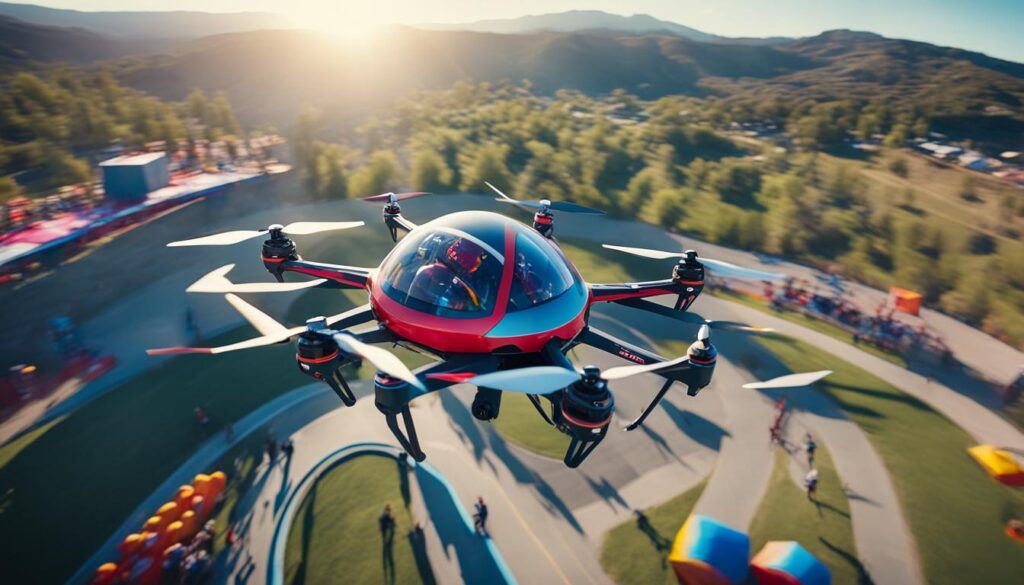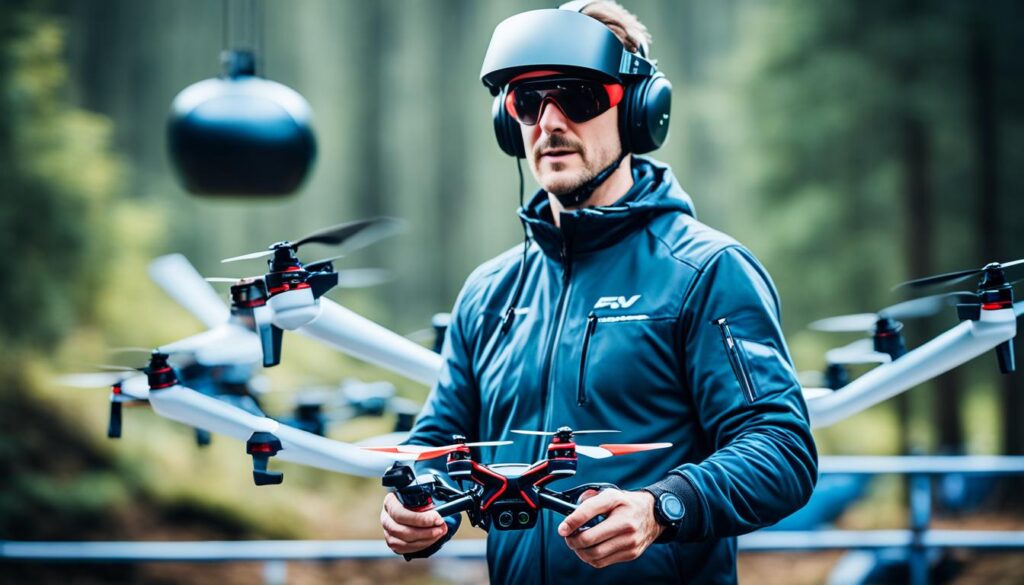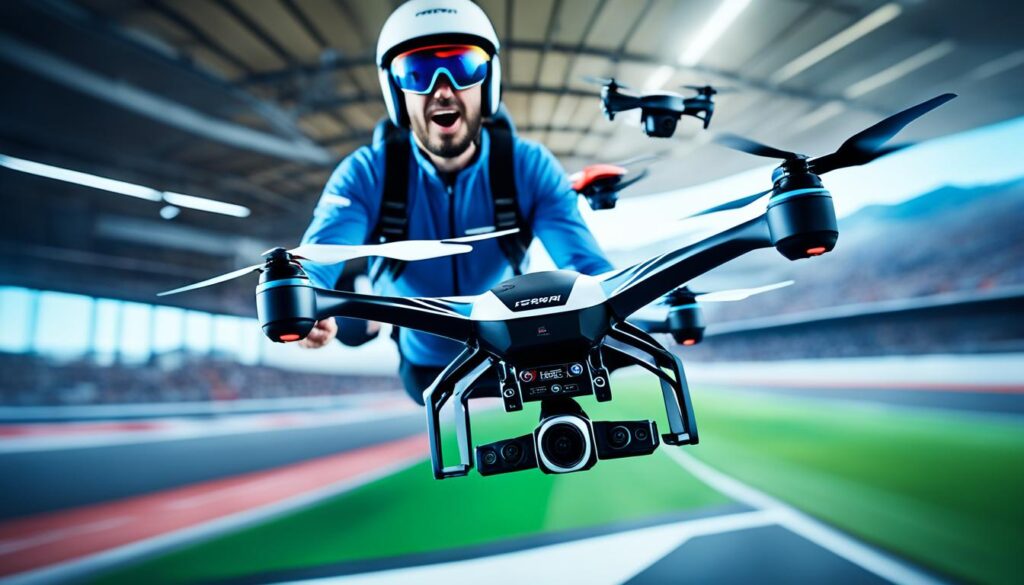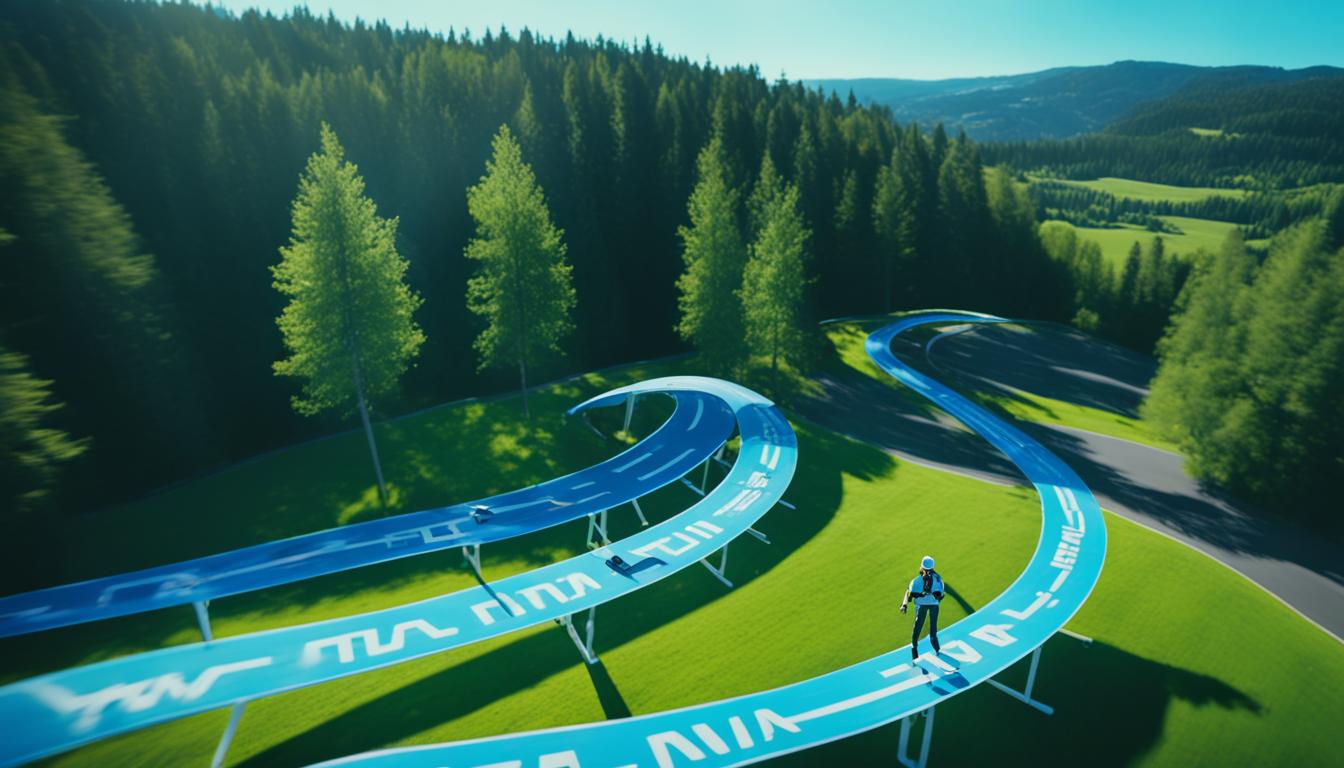Dive into an enthralling world where the sky is not the limit, but your racing track. If you yearn to learn drone racing basics and soar above the rest, this Beginner’s Guide to Drone Racing is your launchpad into an electrifying sport that’s sweeping the nation. Imagine the thrill of First-Person-View (FPV) racing, where you are the pilot, the navigator, and the daredevil, all through the lens of your racing drone.
Since its ignition in the dynamic landscapes of Australia and New Zealand, FPV drone racing has skyrocketed as a global phenomenon. Our guide illuminates the path for aspiring pilots, revealing the essentials of gripping races that demand nothing less than your best. Rev up your curiosity and readiness for a breathtaking introduction to drone racing. Fasten your seatbelts; you’re about to embark on a voyage that promises to elevate your perspective of what it means to fly.
Understanding the Thrill of FPV Drone Racing
FPV drone racing is not merely a sport; it’s a pulsating quest for speed and agility that has captivated enthusiasts around the globe. Distinguished from traditional flight by the First-Person View it offers, this high-octane hobby invites pilots to plunge into a virtually real racing experience. Let’s dive into what makes this sport uniquely thrilling, from its genesis to the modern spectacle created by leagues such as the Drone Racing League.
What Is FPV Drone Racing?
Imagine soaring through the skies, navigating intricate racecourses at breakneck speeds—this is the essence of FPV drone racing. Every twist and turn, every rapid ascent and steep dive, is experienced in real-time by the pilot through the lens of a camera mounted on the drone, bolstered by FPV goggles that stream the flight view directly. For beginners intrigued by drone racing, learning how to race drones starts with grasping this immersive technology. It’s a blend of virtual reality, precise control, and the timeless thrill of racing.

The History and Evolution of Drone Racing
The journey of FPV drone racing began with DIY enthusiasts in Australia and New Zealand, who transformed open fields into arenas of airborne competition. These grassroots events set the stage for the sport’s growth, evolving from rudimentary gatherings to sophisticated showdowns. As technology advanced, so did drone racing, shifting from hobbyist pursuits to structured competitions that demanded not just skill but also strategy and innovation.
Drone Racing Leagues and Competitions
The Drone Racing League has emerged as a bastion of FPV drone racing, where pilots battle for supremacy with cutting-edge drones like the Racer3. The league represents the zenith of what drone racing for beginners can aspire to: a global stage where precision, reflexes, and the raw challenge of rate mode flying come together in a symphony of high-velocity competition. Here, drones zoom devoid of stabilizing features, bringing racers as close as possible to unbridled flight.
In summary, FPV drone racing combines the thrill of competitive sports with the immersive experience of dynamic flight, making it a growing fascination worldwide. For those just beginning their journey, understanding the roots, embracing the technology, and spectating the skillful showdowns in leagues can provide a gateway into the electric world of drone racing.
Essential Equipment for Drone Racing
Embarking on the exciting path of drone racing begins with understanding and selecting the correct gear. As a beginner, equipping yourself with the appropriate technology can make the difference between a turbulent lift-off and a soaring start. Let’s dive into the components you’ll need for your racing setup.
Choosing Your First Racing Drone
A racing drone is your ticket to the world of high-speed aerial competition. These drones are engineered for agility and speed, distinguishing them from the more common camera drones. With no stabilizing sensors, your control needs to be spot-on as you navigate through challenging courses.
For beginners seeking beginner drone racing tips, starting with a model like the Racer3 racing drone is advisable. Its sturdy build and the capability for rapid acceleration give you a taste of what drone racing holds, without overwhelming you.
The Role of FPV Goggles and Controllers
The thrill of drone racing is incomplete without the right set of FPV goggles. These goggles offer a real-time feed from your drone’s camera, placing you right in the pilot’s seat. As for controllers, they serve as the lifeline between you and your drone, translating your every command into fluid movement in the skies.

When selecting controllers, ergonomics and response time are crucial factors. A comfortable grip and responsive controls allow you to execute those tight turns and rapid ascents that competitive racing demands.
Navigating Regulatory Requirements for Drones
In addition to getting the right equipment, being aware of the regulatory requirements for drones in your area is paramount. Drone racing isn’t just about the thrill; it’s also about responsible flying. Whether it’s registering your drone or adhering to local flight restrictions, compliance ensures that the airspace remains safe for everyone.
- Ensure your racing drone is registered with the FAA (Federal Aviation Administration).
- Understand the difference between flying for recreational versus commercial purposes.
- Keep abreast of the latest airspace regulations to avoid any inadvertent violations.
As you collect your gear and build your knowledge, remember that drone racing is a journey. With the right racing drone, FPV goggles, and controller, along with a thorough understanding of regulatory requirements, you are well on your way to becoming a skilled drone racer.
The Fundamentals of Flying a Racing Drone
Embarking on the journey of getting started with drone racing invites enthusiasts to immerse themselves in the mechanics of FPV racing flight. Before pilots can soar through obstacle-laden racecourses, they must become adept at mastering basic maneuvers and understanding the comprehensive drone control techniques that underpin this modern sport.
Each racing drone is equipped with a set of controls that govern its movement: roll, pitch, yaw, and thrust. Mastering the synchronized application of these controls is quintessential for pilots who wish to navigate the skies with precision. To illustrate the synergy of these elements:
| Movement | Function |
|---|---|
| Roll | Controls the drone’s lateral balance, allowing it to tilt side to side. |
| Pitch | Dictates the drone’s forward and backward tilt, crucial for acceleration and deceleration. |
| Yaw | Adjusts the drone’s orientation, essential for navigating turns and directional changes. |
| Thrust | Regulates the altitude and speed, a core component of maneuverability. |

Beginners looking to refine their piloting skills without the inherent risk of crashing can turn to FPV flight simulators. These simulators offer a realistic and immersive training ground to practice and hone flying techniques. Furthermore, components such as ESCs and propellers react to the nuanced inputs the pilot gives through the R/C controller, translating intent into action.
Embrace the agility and freedom of flight by understanding your drone’s abilities and your own potential as a pilot.
In sum, the intoxicating blend of speed and control in drone racing beckons aspiring pilots to not only fly but also to innovate and continuously push the boundaries of what is possible in FPV racing flight.
Getting Up to Speed with Drone Racing Techniques
Embarking on the dynamic path of FPV drone racing encapsulates not just the art of quick reflexes, but also the science of mastering meticulously calculated moves. Aspiring pilots begin their quest for aerial prowess by learning drone racing techniques for newbies, which lay the foundation for all future, more complex racing strategies. Beginning with the essentials, new enthusiasts focus on core skills that serve as the building blocks of competition-level expertise.
Mastering Basic Maneuvers and Controls
Transitioning from a beginner to a proficient competitor means embracing the basics—being able to deftly navigate through tight spaces, execute sharp turns with poise, and manage the throttle for sudden gains or drops in altitude. These basic maneuvers and controls are the quintessential elements of drone racing. Consistent practice is pivotal in enhancing one’s ability to maneuver a race drone with the finesse and speed required to advance in this high-octane sport. With precision and patience, mastery over these techniques becomes second nature.
Advanced Techniques for Competitive Racing
For those ready to venture beyond the basics, advanced racing techniques await, demanding not only dexterity but also a well-honed tactical mindset. Every competitive race is a game of precision and strategy, where knowing how to expertly cut corners or choosing the perfect moment to accelerate can lead to triumphant outcomes. Incorporating complex maneuvers such as coordinated turns and managing momentum during critical race moments can be the difference between victory and mere participation in competitive drone racing.
Training with Drone Racing Simulators
Lastly, for both novices and skilled pilots, the FPV flight simulator offers a training haven where real-world consequences are a nonfactor. It is in this safe, controlled environment that pilots can practice tirelessly, building the muscle memory that translates into exceptional in-field performance. Utilizing simulators is a cost-effective way to train, allowing pilots to push the boundaries of their racing techniques without the fear of damaging valuable equipment. Embracing this technology is a stepping stone to ascending the ranks of proficient drone pilots, ready to compete on the thrilling stage of competitive drone racing.
FAQ
Q: What Is FPV Drone Racing?
A: FPV drone racing is a competitive sport where pilots navigate drones through courses at high speeds, using First-Person-View goggles to see from the drone’s perspective. It combines the thrill of racing with the intricacy of aerial maneuvering.
Q: The History and Evolution of Drone Racing
A: Drone racing began as a hobby among RC enthusiasts in Australia and New Zealand and has since evolved into a professional sport, with formal leagues like the Drone Racing League emerging, featuring high-speed drones and skilled pilots.
Q: Drone Racing Leagues and Competitions
A: There are various drone racing leagues and competitions, including the Drone Racing League (DRL) that hosts international events, which air on channels like ESPN, showcasing pilots competing with advanced drones such as the Racer3.
Q: Choosing Your First Racing Drone
A: When selecting your first racing drone, prioritize a model designed for performance and agility, like the Racer3. It should be well-built to withstand crashes and have the capability for speed and precise movements.
Q: The Role of FPV Goggles and Controllers
A: FPV goggles are essential for experiencing the race as if you’re in the cockpit, providing a live feed from the drone. Controllers are the vital link that interprets your movements into the drone’s actions, allowing for precise control.
Q: Navigating Regulatory Requirements for Drones
A: Each country has its own regulations for flying drones, which often include registration requirements, flying restrictions in certain areas, and adherence to privacy laws. It’s crucial for pilots to understand and follow these to fly legally and responsibly.
Q: Mastering Basic Maneuvers and Controls
A: Basic maneuvers in drone racing include learning how to control roll, pitch, yaw, and thrust. Gaining proficiency in these movements is key to maneuvering a racing drone effectively and is the foundation for more advanced techniques.
Q: Advanced Techniques for Competitive Racing
A: To excel in competitive racing, pilots must develop advanced skills such as throttle control, split-second decision-making, and precise cornering. These techniques help improve lap times and race strategy.
Q: Training with Drone Racing Simulators
A: Drone racing simulators are invaluable tools for practice. They offer a risk-free environment to hone flying skills, build muscle memory, and experiment with different flying styles without the potential for costly crashes.

Leave a Reply